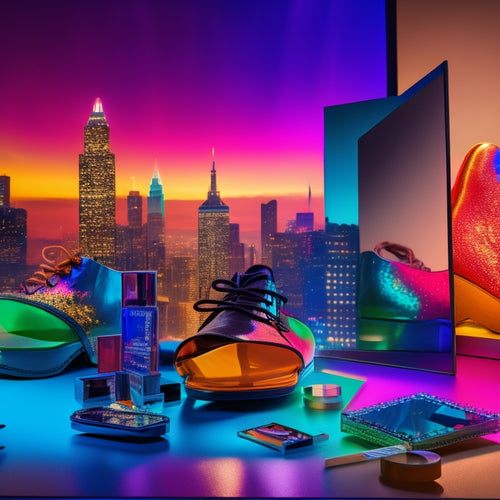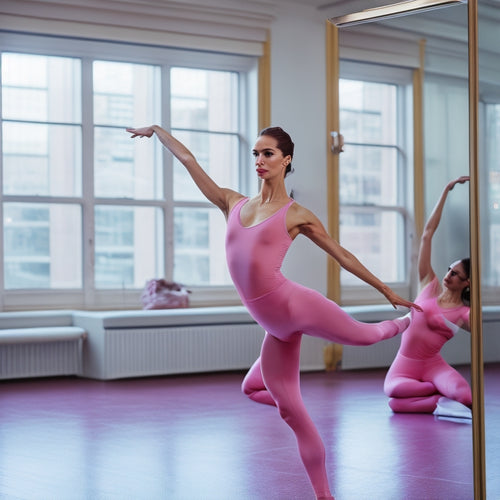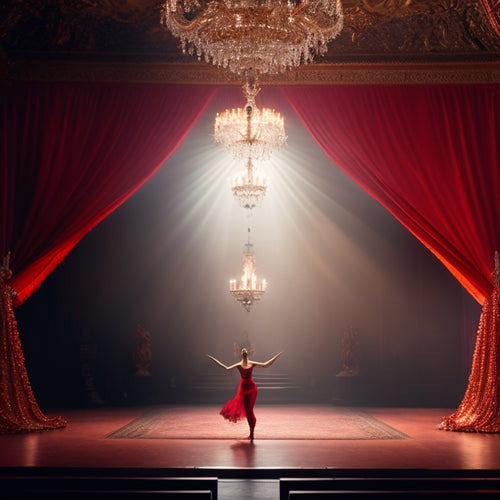
10 Best Online Courses for Dance Makeup Artistry
Share
You're about to tap into your inner dance makeup artist! Get ready to master essential techniques, from hydrated skin prep to prosthetic application, and design visually stunning looks that wow the audience. Explore contouring and feature enhancement, character representation, and special effects to transform dancers into characters. Develop your personal style, refine your skills, and build a professional portfolio that showcases your expertise. From ballet to hip-hop, learn to adapt your artistry to various dance genres. As you immerse yourself in the world of dance makeup artistry, you'll discover the secrets to creating mesmerizing performances that leave a lasting impression.
Key Takeaways
• Look for courses that cover essential skills like skin preparation, product selection, and contouring techniques to create a strong foundation in dance makeup artistry.
• Courses that focus on theatrical makeup design, character representation, and special effects can help artists create visually stunning and transformative looks for dance performances.
• Online courses that provide personalized feedback, critiques, and mentorship can help artists refine their skills, develop their personal style, and build a professional portfolio.
• Courses that cater to specific dance genres, such as ballet, contemporary, or hip-hop, can provide artists with the knowledge to tailor their makeup styles to complement the performance aesthetics and nuances.
• When selecting an online course, consider the instructor's experience in dance makeup artistry, the course's curriculum, and the level of interaction and support provided to ensure a comprehensive learning experience.
Mastering Dance Makeup Essentials
To master the art of dance makeup, you'll need to grasp the fundamentals of skin preparation, product selection, and color theory, which form the foundation of a flawless, high-performance look. As a dance makeup artist, your goal is to create a flawless, long-lasting finish that withstands the demands of intense performances.
This begins with preparing the dance skin, ensuring it's hydrated, smooth, and even-toned. You'll learn how to choose the right products for your dancer's skin type, whether it's a lightweight foundation for a natural look or a more opaque coverage for a dramatic effect.
When it comes to prosthetic application, you'll discover the techniques to seamlessly integrate prosthetic pieces into your design. From creating realistic skin tones to blending edges, you'll master the skills to transform your dancer into a character.
With a solid understanding of color theory, you'll be able to select hues that complement the dancer's skin tone, costume, and overall aesthetic. By mastering these essentials, you'll uncover the secrets to creating breathtaking, high-performance dance makeup looks that elevate your dancer's performance and leave a lasting impression on the audience.
Fundamentals of Theatrical Makeup Design
As you explore the fundamentals of theatrical makeup design, you'll learn to apply design principles to create visually stunning looks that transport the audience to another era.
You'll master period-inspired makeup designs that evoke the glamour of the Roaring Twenties or the opulence of the Renaissance.
Design Principles Applied
In theatrical makeup design, applying fundamental principles of art, such as balance, proportion, and harmony, allows you to create visually stunning, character-driven looks that transport audiences to new worlds.
When you master these design principles, you'll be able to craft makeup designs that aren't just aesthetically pleasing, but also tell a story and evoke emotion.
Color Harmony, for instance, is vital in creating a cohesive look. By selecting hues that complement or contrast with the dancer's skin tone, costume, and set design, you can create a visually appealing palette that enhances the overall performance.
Visual Balance is another essential principle to grasp. By balancing bold, statement pieces with softer, more subtle elements, you can create a sense of harmony and visual flow.
By applying these principles, you'll be able to design makeup looks that not only enhance the dancer's features but also elevate the entire production.
With practice and patience, you'll develop a keen eye for design, and your makeup artistry will take center stage.
Period-Inspired Makeup Looks
You'll explore the rich world of period-inspired makeup looks, where historical references and artistic license blend to create stunning, era-specific designs that transport audiences to bygone eras.
In this domain of Historic Revival, you'll investigate the intricacies of Vintage Glamour, where classic Hollywood's golden age meets modern artistic expression. You'll learn to craft looks that evoke the opulence of the Roaring Twenties, the sophistication of the Victorian era, or the whimsy of the Renaissance.
Through expert guidance, you'll master the techniques to recreate iconic styles, from the subtle nuances of antique patina to the bold statements of retro futurism. You'll discover how to balance historical accuracy with artistic license, ensuring your designs are both authentic and visually stunning.
Enhancing Features With Contouring
By masterfully manipulating light and shadow, you can accentuate your facial features, creating the illusion of defined cheekbones, a slimmer nose, and a more angular jawline through the art of contouring. This technique is all about understanding Facial Anatomy and working with your Skin Types. To contour like a pro, you'll need to identify the areas of your face where shadows naturally fall, and then use makeup to enhance those shadows.
Here's a breakdown of the key contouring zones to focus on:
| Contour Zone | Description |
|---|---|
| Hollows of the cheeks | Creates definition and slimming effect |
| Sides of the nose | Slims and refines the nose shape |
| Jawline | Defines and angles the jaw |
| Temple area | Slenders the face and creates a more angular shape |
| Eye sockets | Adds depth and dimension to the eyes |
Special Effects for Dance Performances
As a dance makeup artist, you're about to ignite your creativity and transform dancers into characters, creatures, or abstract concepts, pushing the boundaries of artistic expression with special effects that electrify the stage. With special effects, you'll create illusions that captivate the audience, transporting them to new worlds and dimensions.
Prosthetic application is an essential skill in this domain, allowing you to attach artificial pieces to the dancer's skin, creating an uncanny realism. You'll learn to blend edges, secure prosthetics, and paint them to seamlessly merge with the dancer's skin tone.
Injury simulation is another critical technique to master, where you'll create realistic wounds, bruises, and scars that tell a story. You'll understand how to use different materials, such as gelatin, liquid latex, or silicone, to create realistic textures and colors.
Developing a Personal Style
Your dance makeup artistry signature unfolds like a canvas, where every brushstroke, color choice, and technique converges to reflect your unique perspective, setting you apart in the world of dance performance.
As you continue to hone your craft, you'll start to develop a personal style that resonates with your artistic voice. This distinctive flair is what sets you apart from others and establishes your brand identity in the industry.
To cultivate a unique style, consider the following:
- Experiment with unconventional color palettes to create bold, eye-catching looks.
- Develop a signature technique, such as intricate designs or bold brushstrokes, to add a personal touch to your work.
- Draw inspiration from various art forms, like fine art or fashion, to infuse your makeup artistry with fresh perspectives.
- Collaborate with dancers and choreographers to understand their vision and create custom looks that enhance their performances.
- Continuously challenge yourself to try new things and push the boundaries of what's possible with dance makeup artistry.
Airbrush Makeup for Dance Artists
As you explore airbrush makeup for dance artists, you'll discover the importance of mastering airbrush techniques to create flawless, high-definition finishes.
Next, you'll learn how to build complex designs that elevate your artistry, from subtle shading to bold, show-stopping statements.
Mastering Airbrush Techniques
With airbrush makeup, you can achieve a flawless, high-definition finish that withstands the intense lighting and energetic movements of dance performances, making it an essential skill for dance makeup artists to master. To take your airbrush skills to the next level, it's important to focus on mastering airbrush techniques.
Here are some key areas to focus on:
-
Airbrush Maintenance: Regularly clean and maintain your airbrush to prevent clogging and maintain smooth, consistent performance.
-
Brush Sanitizing: Sanitize your airbrush with a gentle cleaning solution to prevent bacterial buildup and maintain a hygienic application process.
-
Understanding Air Pressure: Learn to control air pressure to achieve the desired level of coverage, from sheer to full coverage.
-
Mastering Stenciling: Use stencils to create intricate designs and patterns that add an extra dimension to your dance makeup looks.
-
Practicing Blending: Hone your blending skills to create seamless transitions between colors and achieve a natural-looking finish.
Building Complex Designs
By mastering the fundamentals of airbrush makeup, you're now ready to push the boundaries of creativity and build complex designs that elevate your dance makeup artistry to new heights. With a solid foundation in techniques, you can experiment with innovative designs, exploring the intersection of art and makeup. This is where Design Evolution takes center stage, as you refine your skills to create intricate, multi-dimensional looks that mesmerize audiences.
As you venture into the domain of complex designs, you'll discover the art of Makeup Architecture. This involves strategically layering colors, textures, and patterns to craft visually stunning, three-dimensional masterpieces. By manipulating airbrush techniques, you can create intricate details, bold statements, and ethereal effects that transport performers to new dimensions.
With each brushstroke, you'll uncover new possibilities, merging artistry with technical prowess. As you build complex designs, you'll tap into the full potential of airbrush makeup, revolutionizing the world of dance makeup artistry.
Enhancing Performance Looks
You're on the verge of discovering the secrets of amplifying performance looks, where airbrush makeup mastery converges with the dancer's artistic expression, and every brushstroke becomes a critical component of the overall visual narrative.
As you immerse yourself in the world of airbrush makeup for dance artists, you'll reveal the keys to transforming your dance persona and exuding stage confidence.
To take your performance looks to the next level, focus on these essential techniques:
- Mastering airbrush foundation for a flawless, high-definition finish
- Enhancing facial features with subtle, nuanced shading and highlighting
- Creating bold, vibrant colors that pop under stage lighting
- Designing intricate, detailed designs that complement your dance style
- Perfecting a seamless, long-lasting finish that withstands the demands of performance
Creating Character Looks Easily
Mastering the art of creating character looks easily requires an understanding of how to distill a character's essence into a visual representation that resonates with the audience. As a dance makeup artist, you'll want to develop a keen sense of observation, analyzing the character's personality, traits, and backstory to inform your design.
This is where Color Theory comes in – by selecting a palette that aligns with the character's emotional tone, you'll create an instant connection with the audience. For instance, warm tones can evoke feelings of passion and energy, while cool tones can convey calmness and serenity.
When designing your character look, it's essential to consider Facial Anatomy. Study the facial structure, paying attention to the shape of the eyes, nose, and jawline. This will help you accentuate or downplay features to create a more realistic and believable transformation.
Makeup for Various Dance Genres
As you explore the world of dance makeup artistry, you'll find that different genres of dance require distinct makeup styles that not only complement the performance but also enhance the overall aesthetic. Each style demands a unique approach to makeup, and understanding these nuances is essential for a dance makeup artist.
Here are some key considerations for different dance genres:
-
Ballet: Soft, natural makeup that enhances the dancer's features without drawing attention away from the performance. Think subtle earth tones and a natural glow.
-
Hip-Hop: Bold, vibrant colors and statement pieces that match the high-energy vibe of the dance style. Think bright lip colors and metallic eyeshadows.
-
Contemporary: Makeup that emphasizes emotion and expression, with a focus on enhancing the dancer's facial features. Think bold brows and defined cheekbones.
-
Dance Fusion: A blend of different styles, requiring makeup that's equally versatile. Think bold colors and innovative techniques.
-
Cultural Expression: Makeup that honors and celebrates the cultural heritage of the dance style. Think traditional patterns and symbolic motifs.
Building a Professional Portfolio
Creating a professional portfolio is crucial for showcasing your expertise in dance makeup artistry and providing tangible proof of your skills to potential clients and collaborators. Curating a portfolio that highlights your best work, demonstrating your versatility and range as a dance makeup artist, is vital. This visual representation of your skills will help you stand out in the industry, making it easier to attract clients and collaborators.
When building your portfolio, consider your personal branding and how you want to be perceived by your target audience. Your portfolio should reflect your unique style and aesthetic, showcasing your creativity and attention to detail. Utilize social media platforms to showcase your work, sharing behind-the-scenes glimpses into your creative process and interacting with potential clients. By doing so, you'll establish yourself as a credible and sought-after dance makeup artist, opening doors to new opportunities and collaborations.
Advanced Techniques for Stage Presence
What sets a dance makeup artist apart from a mere mortal is the ability to craft a look that not only complements the performer's features but also amplifies their stage presence, creating an unforgettable visual experience that electrifies the audience. As a dance makeup artist, you know that a performer's confidence is essential to their success on stage. Your job is to enhance their natural beauty, making them feel like a rockstar. But how do you achieve that?
Here are some advanced techniques to take your stage presence to the next level:
-
Highlighting the eyes: Accentuate the performer's eyes to create a sense of depth and dimension, drawing the audience's attention to their emotional expression.
-
Contouring for definition: Use shadows and highlights to create the illusion of defined cheekbones, a slimmer nose, and a more angular jawline, giving the performer a more dramatic appearance.
-
Luminous skin: Achieve a flawless, radiant complexion that glows under the stage lights, boosting the performer's confidence and captivating the audience.
-
Vibrant colors: Select bold, vibrant shades that pop under the lights, creating a mesmerizing visual experience that electrifies the audience.
-
Customization for performance anxiety: Design a look that addresses the performer's specific needs, alleviating performance anxiety and building confidence.
Frequently Asked Questions
Can I Learn Dance Makeup Artistry if I Have No Prior Experience?
With no prior experience, you can still tap into your natural talent for dance makeup artistry, embracing creative freedom to experiment and learn, as you discover your unique style and flair.
How Long Does It Take to Complete a Dance Makeup Artistry Course?
'Did you know 75% of online learners complete courses in 3-6 months? You'll complete a dance makeup artistry course in 1-6 months, depending on your study pace; accelerate your learning and tap into your creativity!'
Do I Need to Invest in Expensive Makeup Products for the Course?
You won't need to break the bank on expensive makeup products for the course; explore affordable brand options that offer high-quality products, and prioritize investing in a few versatile, high-pigment shades that'll elevate your dance makeup artistry skills.
Can I Use These Skills for Freelance or Business Opportunities?
'You'll unleash entrepreneurial ventures, crafting a unique business branding that showcases your artistry. Develop marketing strategies to acquire clients, and master financial planning to turn your passion into a lucrative career, giving you the freedom you crave.'
Are Online Courses Suitable for Those With Limited Time or Schedule Constraints?
"Life is a canvas, and time is your brush - you paint your schedule. Online courses are perfect for busy professionals like you, offering flexible schedules, self-paced learning, and effective time management, so you can create your masterpiece, on your terms."
Related Posts
-

3 Essential Marketing Tips for Dance Makeup Artists
To shine online and attract new clients, you'll need a solid marketing strategy. First, boost your online visibility ...
-

Dance Practice Wear Picks for Maximum Comfort and Performance
When choosing dance practice wear, you want gear that optimizes comfort and performance. Opt for moisture-wicking fab...
-

Dance Spectacular With Limited Seating Offer
Experience the magic of dance with Santa Barbara Festival Ballet's 'Growing Up With Dance' spectacular, featuring bre...


